 Once you become the proud owner of a new sit stand workstation, there’s a good chance you’ll consider investing in some standing desk accessories as well.
Once you become the proud owner of a new sit stand workstation, there’s a good chance you’ll consider investing in some standing desk accessories as well.
But choosing the right add-ons can be a daunting task. With so many different types and styles to choose from, where do you even start?
Which accessories might work for you and how exactly will you use them? In fact, do you even need any of these additions to your office set up?
In today’s post we’ve covered some of the most popular types of standing desk accessories. We’ll take a look at what they are and how they may help to boost your health and productivity even further.
But first of all, let’s take a look at the basics of office ergonomics and why it’s so important to get it right.
Office Ergonomics Basics
What Is Office Ergonomics?
In very simple terms, office ergonomics means a good fit between the office worker and the equipment and furnishings they use. From ensuring that desk and chair height are correct to the best positioning for monitors, mouse and keyboard. Plus much more in between. Optimum office ergonomics can improve comfort and productivity, along with reducing aches, pains, strains and long-term physical disorders.
So let’s take a look at 7 of the most popular standing desk accessories, along with some tips for making them work best for you.
Top 7 Standing Desk Accessories
Ergonomic Mice
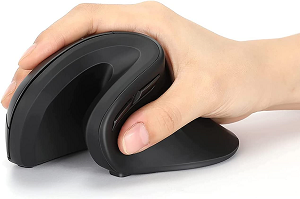 Ergonomic mice are designed to be a better fit for the hand.
Ergonomic mice are designed to be a better fit for the hand.
Their unusual shape makes for more natural positioning, meaning more comfort and less strain on the hands and arms.
They also require less gripping, and although even old-style mice require fairly minimal clutching, you might be surprised at how much tension can build up throughout the day.
Add the days, weeks and months up and you could find yourself with one of many musculoskeletal disorders or repetitive strain injuries.
There are different shapes and styles available, but generally you’ll find that ergonomic mice are more upright with a vertical slant. Some offer additional wrist support, others are shaped in particular to support the thumb.
If possible, have a try before you buy to see which shape and style works best for you.
Ergonomic Keyboards
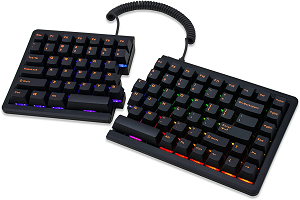 Ergonomic keyboards allow you to position your hands more comfortably whilst typing.
Ergonomic keyboards allow you to position your hands more comfortably whilst typing.
On some designs, the keyboard is a single unit divided into 2 halves. Others feature an actual split so you have 2 independent halves to work from. Other designs have the keyboard split into quarters.
For additional comfort, some models feature varying degrees of curving and may come with a built-in wrist support.
But do they actually work?
Ergonomic keyboards can help to prevent strain and injury – mainly to the hands and arms. With more flexibility you can find the best positioning for your hands and wrists, thereby improving comfort and safety.
But getting used to these often weird and wonderful shaped keyboards can be challenging for some. If you do decide to go down this route, be prepared for a bedding-in period.
Keyboard Trays
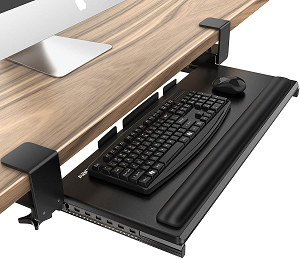 Keyboard trays attach to your desk – usually underneath – allowing you to position your keyboard a few inches lower than your desktop.
Keyboard trays attach to your desk – usually underneath – allowing you to position your keyboard a few inches lower than your desktop.
This makes for a more comfortable typing experience and can help to take the strain off of your hands and wrists.
This in turn can help to reduce the risk of a number of repetitive strain injuries which affect the muscles, nerves and tendons.
At the least, your hands and wrists should be at a neutral angle, as opposed to a positive tilt whereby your hands are working at a higher level than your wrists.
For even more comfort and kindness, look for a keyboard tray with a negative tilt. This will take further strain from your hands and wrists, and a tilt of up to around 20° is recommended.
By lowering the input level, keyboard trays can give shorter users an affordable solution to a poorly fitting desk. They are also a good way to free up your valuable desktop space.
TOP TIPs
- Make sure your keyboard tray is large enough for both your keyboard and your mouse.
- Choose a tray with the correct fittings for your desk. Screws work fine with wooden desktops but you’ll need a clamp attachment if you have a metal or glass top.
- Decide whether a fixed or retractable tray would be the best fit for your needs and the space you have to work with.
- Choose a tray with a built in wrist pad for additional support and comfort.
Monitor Arms
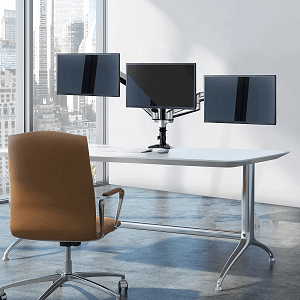 Also known as monitor mounts or brackets, these accessories help you to find the best ergonomic positioning for your screen, taking the strain off of your eyes, neck and upper back.
Also known as monitor mounts or brackets, these accessories help you to find the best ergonomic positioning for your screen, taking the strain off of your eyes, neck and upper back.
The top of the screen should be just below your eye level, and there should be at least 20 inches between you and your monitor.
As well as moving up and down, some mounts tilt, rotate or can be moved in and outwards.
You can choose between free-standing models or others which clamp onto your desk or bolt on via a grommet hole. Alternatively you could opt for a wall mount.
Whether you use a single or multiple monitor set up, there are specific designs for each. As well as helping to reduce aches, pains and strains due to poor screen positioning, they’re also another great way to free up some desktop space.
Balance Boards
 Alternating between sitting and standing throughout the day is a great way to improve your health and productivity.
Alternating between sitting and standing throughout the day is a great way to improve your health and productivity.
You can make standing more comfortable by using a balance board specifically designed for the office. These help to reduce fatigue and alleviate aches and pains.
Put simply, balance boards require you to find your balance as you stand, working the foot and leg muscles. They also help you to keep the core muscles engaged as you maintain a more upright posture.
Balance boards come in different shapes and sizes, with varying degrees of movement and balance needed.
The simplest versions may feature 2 or 4 pivots, requiring minimal effort as you find the right stance. Others have a ball in the centre with a ring around the edge which you place your feet on. These types are more challenging but a great way to add a little fun to the office.
Just remember to mix it up as standing for too long can also have a negative impact on your health and productivity. Experts recommend changing from sitting to standing every 30 – 60 minutes.
Anti-Fatigue Mats
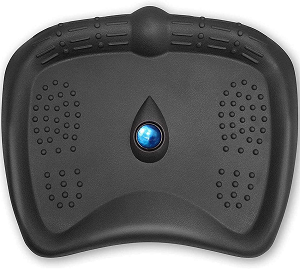 As with balance boards, anti-fatigue mats help you to avoid aches and pains whilst standing.
As with balance boards, anti-fatigue mats help you to avoid aches and pains whilst standing.
Some simply offer a couple of inches of thick foam as an alternative to standing on a hard floor.
Others have all manner of lumps, bumps and nodules for you to stretch and flex your toes and soles on. (Get the maximum benefit from these types by taking your shoes off.)
As well as reducing foot fatigue, this is great for the circulation. Even the smallest of movements can contribute to better health whilst standing. They can help to reduce stress on the joints and pain or discomfort in the lower legs and feet.
If it’s not safe, hygienic or acceptable to take your shoes off in the office, at the very least make sure your footwear is suitable for standing and working.
Ergonomic Seating
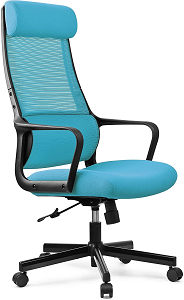 Just as comfort and safety is important for standing work, it shouldn’t be overlooked for seated work as well.
Just as comfort and safety is important for standing work, it shouldn’t be overlooked for seated work as well.
There’s a vast range of ergonomic seating out there. The key things to consider when looking for the right chair or stool are as follows :
- Can the height be adjusted to give you correct positioning and better posture?
- Does the seat offer lumbar support for the lower back?
- Do you prefer a chair with or without arms?
- Do you require a tilt function for the back rest or seat?
- Is there sufficient padding and cushioning to give maximum comfort?
You may also want to consider active office seating. This type of seating is more about being dynamic when you’re sitting, rather than being static and risking the slouch.
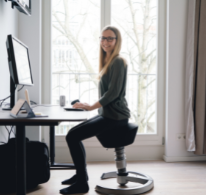 Active seating comes in the form of wobble chairs, kneeling stools, leaning or perching chairs, balance ball chairs and more.
Active seating comes in the form of wobble chairs, kneeling stools, leaning or perching chairs, balance ball chairs and more.
It’s important to do your homework before you buy, especially if you have health or mobility issues.
Some types are more challenging than others, but they can be a great way to reduce aches, pains and fatigue. Ideal for engaging and strengthening the core muscles.
Whichever type you go for, be sure to check that your chosen chair or stool is the right match for your size and weight.
| For further Information on the correct workstation set up, take a look at the Health and Safety Executive Display Screen Equipment (DSE) Checklist. |
Standing Desk Accessories – The Takeaway
 Each of the standing desk accessories we’ve looked at can help to prevent or alleviate all manner of aches and pains.
Each of the standing desk accessories we’ve looked at can help to prevent or alleviate all manner of aches and pains.
Left untreated, these aches and pains can develop into a number of different health issues over time, such as carpal tunnel syndrome, tendonitis and back injury.
By getting your ergonomics right, you’re giving your body the best opportunity to work comfortably and safely.
So whether you have an existing condition, or are keen to avoid any of the painful disorders which can be bought on by unhealthy working, consider which accessories could work best for you.
We’ll be covering each of the featured standing desk accessories in more detail, so be sure to come back soon and take a look. In the meantime, feel free to drop us a line with any questions or comments. Use the box below or email jane@standingdeskuk.com.
Working from home without an office to call your own? Having clear boundaries between your work and home life is a must. Turn the HOW? into WOW! with these folding room divider ideas for your home office.

